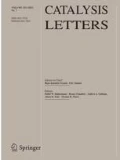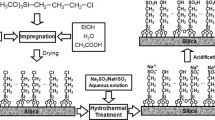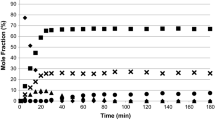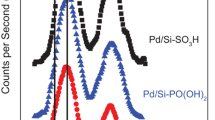Abstract
The acid strengths and catalytic activities of sulfonic acids supported on polystyrene resins and ordered mesoporous HMS and SBA-15 silicas are compared. Acid strengths are measured by acid–base titration calorimetry in terms of the molar enthalpies of neutralisation with either NaOH or n-butylamine in water, acetonitrile and cyclohexane. Catalytic activities (turnover numbers) are reported in model reactions in water, 1,2-dichlorobenzene and anisole, and compared with acid strengths. In water, sulfonated resins are both stronger acids and more active catalysts than sulfonated silicas. Catalytic activities in water correlate well with these measured acid strengths. In acetonitrile the order of acid strengths is reversed and the sulfonated silicas are the stronger acids. Catalytic measurements in 1,2-dichlorobenzene, a similar dipolar aprotic solvent, show the same reversed order of activities. In the non-polar solvent cyclohexane (where only macroporous sulfonated resins show measurable acidity) the sulfonated silicas are again the stronger acids but by a larger margin. Catalytic activities in anisole, which is also only very weakly solvating towards sulfonic acid groups, show a similar trend. The results illustrate the role of the solvent in controlling the acid strength of solid acid catalysts, and the importance of taking this into account when designing acid catalysts for liquid phase processes.
Similar content being viewed by others
References
A. Chakrabarti and M. M. Sharma, React. Polym. 20 (1993) 1.
B. Corain, M. Zecca and K. Jerabek, J. Molec. Catal. A:Chem. 177 (2001) 3.
J. Tejero, F. Cunill, M. Iborra, J. F. Izquierdo and C. Fite, J. Mol. Catal. A:Chem. 182 (2002) 541.
W. M. Van Rhijn, D. E. DeVos, B. F. Sels, W. D. Bossaert and P. A. Jacos, J. Chem. Soc., Chem. Commun. 182 (1998) 317.
W. D. Bossaert, D. E. DeVos, W. M. Van Rhijn, J. Bullen, P. J. Grobet and P. A. Jacobs, J. Catal. 182 (1999) 156.
D. Margolese, J. A. Melero, S. C. Christiansen, B. F. Chmelka and G. D. Stucky, Chem. Mater. 12 (2000) 2448.
S. Koujout and D. R. Brown in: Catalysis in Application Application, eds. S. D. Jackson, J. S. J. Hargreaves and D. Lennon (Royal Society of Chemistry, London, 2003)pp. 178–185.
S. Koujout, B. M. Kiernan, D. R. Brown, H. G. M. Edwards, J. A. Dale and S. Plant, Catal. Lett. 85 (2003) 33.
M. Hart, G. Fuller, D. R. Brown, C. Park, M. A. Keane, J. A. Dale, C. M. Fougret and R. W. Cockman, Catal. Lett. 72 (2001) 135.
C. Buttersack, H Widdeske and J. Klein, React. Polym. 5 (1987) 181.
M. Hart, G. Fuller, D. R. Brown, J. A Dale and S. Plant, J. Mol. Catal. A:Chem. 182 –183 (2002) 439.
F. Ancilloti, M. M. Mauri and E. Pescaraollo, J. Catal. 46 (1977) 49.
K. Jerabek and K. Setinek, J. Mol. Catal. 39 (1987) 161.
J. H. Ahn, S. K. Ihn and K. S. Park, J. Catal. 113 (1988) 434.
P. T. Tanev and T. J. Pinnavaia, Science 267 (1995) 865.
D. Zhao, J. Feng, Q. Huo, N. Melosh, G. H. Fredrickson, B. F. Chmelka and G. D. Stucky, Science 279 (1998) 548.
E. M. Arnett, R. A. Haaksma, B. Chawla and M. H. Healy, J. Am. Chem. Soc. 108 (1986) 4888.
E. M. Arnett, T. Absan and K. Amarnath, J. Am. Chem. Soc. 113 (1991) 6858.
R. S. Drago and N. Kob, J. Phys. Chem. B 101 (1997) 3360.
C. Chronister and R. Drago, J. Am. Chem. Soc. 115 (1993) 4793.
C. E. Harland, Ion Exchange:Theory and Practice 2nd Ed, (Royal Society of Chemistry, London, 1994).
M. J. Climent, A. Corma, S. Iborra and M. C. Navarro, J. Catal. 161 (1996) 783.
Y. Tanaka, N. Sawamura and M. Iwamoto, Tet. Lett. 39 (1998) 9457.
J. Deutsch, V. Quashning, E. Kemnitz, A. Auroux, H. Ehwald and H. Lieske, Top. Catal. 13 (2000) 281.
R. Thornton and B. C. Gates, J. Catal. 34 (1974) 275.
M. D. Grieser, A. D. Wilks and D. J. Pietrzyk, Anal. Chem. 44 (1972) 671.
Author information
Authors and Affiliations
Rights and permissions
About this article
Cite this article
Koujout, S., Brown, D. The Influence of Solvent on the Acidity and Activity of Supported Sulfonic Acid Catalysts. Catalysis Letters 98, 195–202 (2004). https://doi.org/10.1007/s10562-004-8680-3
Issue Date:
DOI: https://doi.org/10.1007/s10562-004-8680-3




